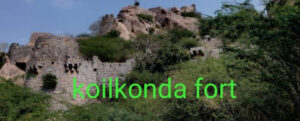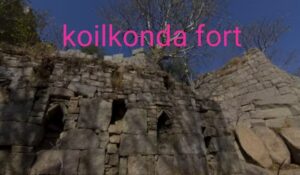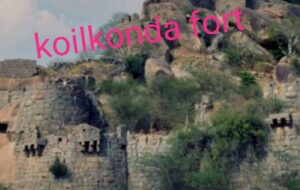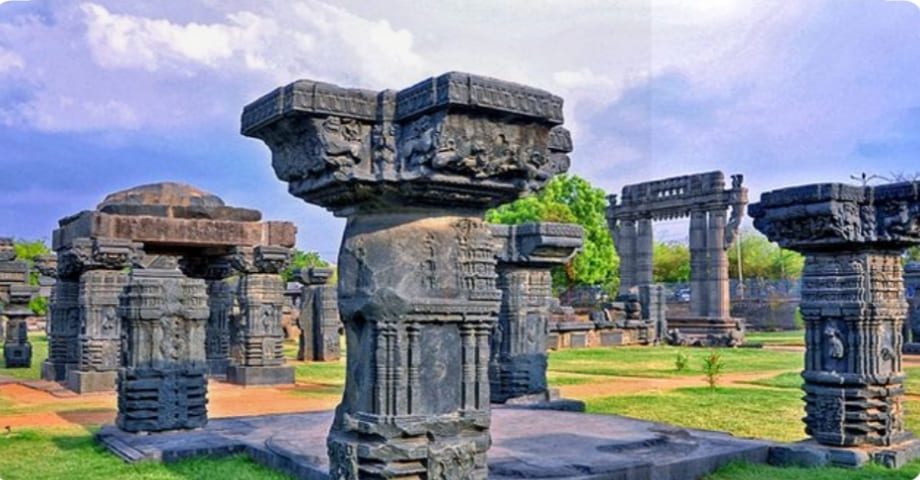The scenic landscape of Telangana, India, Koilkonda Fort stands as a testament to centuries of rich history and cultural heritage. Originally built during the Kakatiya dynasty, this formidable fortress has witnessed the ebb and flow of empires, from the Bahmani Sultanate to the Qutb Shahi dynasty. Strategically perched atop a hill, Koilkonda Fort served as a crucial stronghold, guarding trade routes and commanding awe-inspiring views of the surrounding countryside. Its towering ramparts and intricate architecture continue to captivate travelers and history enthusiasts, offering a window into the storied past of the region.

1.History of Koilkonda Fort
• Provide a detailed historical background of the fort.
Koilkonda Fort historical roots delve deep into the annals of the Kakatiya dynasty’s reign, originally erected to fortify against external threats in Telangana, India. During the 14th century, the Bahmani Sultanate recognized its strategic value, augmenting its defenses and expanding its reach over key trade routes. Amidst successive dynastic shifts, the fort endured as a symbol of power and military prowess, particularly under the Qutb Shahi dynasty’s stewardship. Despite waning military significance over time, Koilkonda Fort remains a poignant testament to the region’s tumultuous past, drawing visitors to its formidable ramparts and echoing corridors steeped in history.
• Discuss its construction during the Kakatiya dynasty.
The construction of Koilkonda Fort during the Kakatiya dynasty represents a remarkable feat of medieval engineering and strategic planning. Under the rule of the Kakatiya kings, who reigned over parts of present-day Telangana and Andhra Pradesh in southern India, the fort was erected to fortify the region against external threats and secure control over key trade routes.
Built atop a rugged hill, the fort’s location provided a natural advantage, offering panoramic views of the surrounding landscape while making it difficult for potential invaders to approach undetected. The Kakatiya architects and engineers utilized locally available materials such as stone and lime mortar to construct the fort’s walls, bastions, and gateways, ensuring its resilience against hostile forces.
The design and layout of Koilkonda Fort reflect the military strategies employed by the Kakatiya dynasty, with multiple layers of defenses, fortified walls, and watchtowers strategically positioned to deter and repel attacks. The fort’s strategic significance as a stronghold along the trade routes further emphasized the importance of its construction during the Kakatiya era.
Koilkonda Fort stands as a testament to the ingenuity and foresight of the Kakatiya dynasty, enduring as a lasting legacy of their reign and contributing to the rich tapestry of historical monuments in the region. Its construction reflects the era’s architectural and military advancements while offering insights into the socio-political landscape of medieval Deccan India.
• Explore its strategic importance during various periods of history, including the Bahmani Sultanate and Qutb Shahi dynasty.
Koilkonda Fort’s strategic importance transcended different epochs of history, evolving as a pivotal stronghold during the reigns of the Bahmani Sultanate and the Qutb Shahi dynasty in the Deccan region of India.
• Bahmani Sultanate Era (14th-16th century):
Under the Bahmani Sultanate, Koilkonda Fort served as a critical military outpost, guarding the Sultanate’s territorial interests and controlling trade routes.
Its elevated position and fortified walls made it an imposing barrier against rival kingdoms and marauding armies.
The fort’s strategic location facilitated the Sultanate’s expansionist policies and enabled them to consolidate their authority over the Deccan plateau.
Koilkonda became a symbol of Bahmani power and influence, projecting strength and dominance over the surrounding countryside.
• Qutb Shahi Dynasty (16th-17th century):
During the reign of the Qutb Shahi dynasty, Koilkonda Fort underwent significant enhancements, with further fortifications and infrastructure improvements.
The Qutb Shahi rulers recognized the fort’s strategic significance as a key defensive position against external threats and internal rebellions.
Koilkonda served as a base for military campaigns and diplomatic endeavors, exerting control over neighboring territories and vassal states.
Its proximity to the Golconda Fort, the Qutb Shahi capital, further solidified its importance as a strategic asset in the region’s defense network.
Throughout its history, Koilkonda Fort played a crucial role in shaping the political and military landscape of the Deccan region. Its strategic location, formidable defenses, and historical legacy made it a prized possession for successive rulers seeking to exert authority and control over the fertile plains below. The fort’s enduring significance underscores its enduring relevance as a symbol of power and resilience in the face of changing tides of history.

2. koilkonda fort: Architectural Marvels
• Describe the architectural features of Koilkonda Fort.
Koilkonda Fort architectural features reflect the ingenuity and craftsmanship of its builders across different periods of history. Situated atop a rugged hill in Telangana, India, the fort boasts a blend of structural elements that highlight its strategic and defensive nature:
1. Fortified Walls: The fort is enclosed by massive stone walls, several meters thick and reinforced with bastions and towers at strategic intervals. These walls served as the primary line of defense, protecting the inner citadel from enemy incursions.
2. Gateways: Koilkonda Fort features imposing gateways adorned with intricate carvings and decorative motifs. These gateways served as the main entrances to the fort, often flanked by watchtowers and defensive structures to monitor and control access.
3. Bastions and Watchtowers: Scattered throughout the fort are numerous bastions and watchtowers, offering panoramic views of the surrounding landscape and serving as vantage points for defense and surveillance. These structures provided a strategic advantage by enabling defenders to spot approaching enemies and mount effective countermeasures.
4. Citadel and Palaces: Within the fortified walls lies the citadel, a central stronghold housing administrative buildings, granaries, and residences for the ruling elite. The citadel often featured ornate palaces, audience halls, and courtyards adorned with architectural embellishments reflecting the grandeur of the era.
5. Water Storage and Reservoirs: Given its strategic location, Koilkonda Fort includes provisions for water storage and reservoirs to sustain the garrison during prolonged sieges or periods of drought. These reservoirs were ingeniously designed to collect and store rainwater, ensuring a reliable water supply for the fort’s inhabitants.
6. Secret Passages and Escape Routes: Legends abound of secret passages and underground tunnels within Koilkonda Fort, providing clandestine means of ingress and egress for the defenders during times of crisis. These hidden pathways added an element of mystery and intrigue to the fort’s architectural layout, allowing for covert operations and strategic retreats if necessary.
Koilkonda Fort architectural features bear testimony to its storied past and enduring legacy as a symbol of power and resilience in the face of adversity. Despite the ravages of time and periodic conflicts, the fort’s imposing ramparts and timeless charm continue to captivate visitors, offering a glimpse into the architectural marvels of medieval India.
• Discuss the unique design elements that make it stand out among other forts in the region.
Koilkonda Fort stands out among other forts in the region due to several unique design elements that reflect its strategic significance and architectural ingenuity:
1. Hilltop Location: Unlike many forts that are built on plains or lower elevations, Koilkonda Fort is strategically situated atop a rugged hill. This natural advantage provides unparalleled panoramic views of the surrounding landscape while offering a commanding position for defense against potential invaders.
2. Multiple Layers of Defense: The fort’s design incorporates multiple layers of defense, including fortified walls, bastions, and watchtowers strategically positioned to thwart enemy advances. These defensive structures are interconnected by narrow pathways and staircases, creating a labyrinthine layout that confounded attackers and facilitated the movement of defenders.
3. Ingenious Water Management Systems: Despite its elevated location, Koilkonda Fort features ingenious water management systems, including reservoirs and storage tanks, designed to collect and store rainwater for consumption during times of siege or scarcity. These systems highlight the fort’s self-sufficiency and resilience in sustaining its inhabitants during prolonged conflicts.
4. Architectural Fusion: Koilkonda Fort showcases a unique blend of architectural styles and influences, reflecting the diverse cultural heritage of the region. From the intricate carvings adorning its gateways to the imposing ramparts guarding its perimeter, the fort’s architecture bears traces of Kakatiya, Bahmani, and Qutb Shahi design elements, making it a living testament to the region’s rich historical legacy.
5. Strategic Layout: The fort’s layout is meticulously planned to maximize defensive capabilities while facilitating efficient administration and governance. Key structures, such as the citadel, palaces, and administrative buildings, are strategically positioned within the fortified walls, creating a cohesive and functional urban ensemble that balances military exigencies with civic needs.
6. Mystique and Intrigue: Legends and folklore surrounding Koilkonda Fort add an aura of mystique and intrigue to its architectural allure. Tales of secret passages, hidden chambers, and underground tunnels evoke a sense of wonder and fascination, inviting visitors to unravel the mysteries concealed within its ancient walls.
Koilkonda Fort unique design elements, coupled with its rich historical legacy and cultural significance, distinguish it as a jewel among the forts of the region. Its commanding hilltop location, ingenious water management systems, and architectural fusion reflect the ingenuity and resilience of its builders, while its mystique continues to captivate the imagination of visitors from far and wide.
3. koilkonda fort: Legends and Folklore
• Share any myths or legends associated with Koilkonda Fort.
Koilkonda Fort is steeped in myths and legends that add to its allure and mystique:
1. The Hidden Treasure: One of the most enduring legends surrounding Koilkonda Fort revolves around a hidden treasure buried within its labyrinthine passages. According to local folklore, a wealthy ruler once hid his vast riches within the fort’s walls to safeguard them from invaders. Despite numerous attempts to uncover the treasure, it remains elusive, shrouded in mystery and intrigue.
2. The Curse of the Sorceress: Another popular legend tells of a powerful sorceress who resided within Koilkonda Fort centuries ago. It is said that she placed a curse upon the fort, condemning anyone who dared to disturb its tranquility. Visitors claim to have encountered eerie apparitions and strange phenomena within the fort’s confines, attributing them to the sorceress’s lingering presence.
3. The Tale of the Star-Crossed Lovers: According to local lore, Koilkonda Fort was witness to a tragic love story between a noble warrior and a beautiful maiden from a rival kingdom. Forbidden from being together by their feuding families, the lovers are said to have met clandestinely within the fort’s hidden chambers, their love enduring even in the face of adversity.
4. The Ghostly Sentinel: Some visitors claim to have encountered the ghost of a valiant sentinel who once guarded Koilkonda Fort with unwavering dedication. Legend has it that his spirit continues to roam the ramparts, keeping vigil over the fort and its secrets for eternity.
5. The Mysterious Drum Beats: Locals speak of hearing mysterious drum beats emanating from within the depths of Koilkonda Fort during the stillness of the night. Some attribute these spectral sounds to the restless spirits of soldiers who perished defending the fort, while others believe them to be a harbinger of impending doom.
These myths and legends contribute to the enigmatic aura surrounding Koilkonda Fort, captivating the imagination of visitors and inspiring tales of adventure and intrigue. While their veracity may be subject to interpretation, they serve to enrich the cultural tapestry of the region and underscore the fort’s timeless allure as a repository of history and mystery.
• Discuss popular folklore or local stories that have been passed down through generations.
Koilkonda Fort is enveloped in a tapestry of popular folklore and local stories that have been passed down through generations, each adding to its aura of mystery and intrigue:
1. The Tale of the Brave Warrior: According to local folklore, Koilkonda Fort was once the stronghold of a legendary warrior who defended the region against invading armies. Tales of his valor and prowess in battle have been immortalized in songs and oral traditions, inspiring admiration and reverence among the local populace.
2. The Sacred Spring: Legend has it that within the confines of Koilkonda Fort lies a sacred spring whose waters possess mystical properties. It is believed that those who drink from the spring will be blessed with good fortune and protection from harm. Pilgrims and travelers often visit the fort to seek the blessings of the sacred spring and pay homage to its divine presence.
3. The Echoes of the Past: Many visitors to Koilkonda Fort claim to have heard faint echoes of voices and footsteps resonating through its ancient corridors. Some believe these echoes to be the lingering remnants of conversations and footsteps from centuries past, while others attribute them to the restless spirits of those who once inhabited the fort.
4. The Enchanted Garden: There are whispers of an enchanted garden hidden within the walls of Koilkonda Fort, where exotic flowers bloom year-round and magical creatures roam freely. According to legend, only those with pure hearts and noble intentions can gain entry to the garden and partake of its otherworldly beauty.
5. The Guardian Spirits: Locals believe that Koilkonda Fort is guarded by benevolent spirits who watch over its hallowed grounds and protect it from harm. These guardian spirits are said to manifest themselves in times of need, guiding and assisting those who seek solace and refuge within the fort’s ancient walls.
6. The Haunted Tower: One of the most enduring legends surrounding Koilkonda Fort is that of the haunted tower, where the ghost of a wronged princess is said to roam in eternal sorrow. According to the tale, the princess was betrayed by her lover and imprisoned within the tower, where her anguished cries can still be heard on moonlit nights.
These popular folklore and local stories weave a rich tapestry of tradition and belief, imbuing Koilkonda Fort with an air of mystique and enchantment that continues to captivate the imagination of visitors and residents alike. As each tale is passed down through the generations, the fort’s legacy grows ever richer, echoing with the whispers of the past and the dreams of the future.

4.koilkonda fort: Tourist Attractions
• Highlight key points of interest within Koilkonda Fort.
Koilkonda Fort, steeped in history and architectural splendor, offers visitors a myriad of captivating points of interest to explore:
1.Fortified Walls and Gateways: The imposing stone walls and intricately carved gateways of Koilkonda Fort greet visitors with a sense of grandeur and antiquity, inviting them to step back in time and immerse themselves in centuries of history.
2.Citadel and Royal Quarters: Within the fortified walls lie the remnants of the citadel, once the seat of power and governance for the fort’s rulers. Visitors can explore the ancient ruins of palaces, audience halls, and administrative buildings, marveling at the architectural marvels of a bygone era.
3.Bastions and Watchtowers: Scattered throughout the fort are bastions and watchtowers offering panoramic views of the surrounding countryside. These vantage points provide an ideal setting for photography enthusiasts and history buffs to capture the fort’s timeless beauty and strategic significance.
4.Secret Passages and Underground Tunnels: Legends abound of secret passages and underground tunnels crisscrossing beneath Koilkonda Fort, shrouded in mystery and intrigue. Adventurous visitors can embark on a quest to uncover these hidden pathways and unlock the secrets they hold.
5.Historical Inscriptions and Carvings: The walls of Koilkonda Fort bear witness to centuries of human endeavor and artistic expression, with intricate carvings and inscriptions that tell the tales of warriors, kings, and dynasties long past. History enthusiasts can decipher these ancient symbols and uncover the stories they conceal.
6.Sacred Temples and Shrines: Nestled within the fort’s precincts are sacred temples and shrines dedicated to deities revered by generations of worshippers. These spiritual sanctuaries offer a tranquil retreat for contemplation and reflection amidst the fort’s bustling thoroughfares.
7.Panoramic Viewpoints: The summit of Koilkonda Fort affords breathtaking panoramic views of the surrounding landscape, stretching as far as the eye can see. Visitors can gaze upon rolling hills, verdant valleys, and meandering rivers, soaking in the natural beauty of the Deccan plateau.
8.Echoes of the Past: As dusk descends upon Koilkonda Fort, echoes of the past reverberate through its ancient corridors and ramparts. Visitors can bask in the aura of centuries-old tales and legends, feeling the palpable presence of those who once walked its hallowed grounds.
These key points of interest within Koilkonda Fort offer a glimpse into its storied past and timeless allure, beckoning travelers from far and wide to embark on a journey of discovery and exploration.
5. koilkonda fort: Surrounding Area and Natural Beauty
• Discuss the lush greenery, hills, and water bodies in the vicinity.
The vicinity surrounding Koilkonda Fort is characterized by lush greenery, undulating hills, and serene water bodies, creating a picturesque landscape that enchants visitors with its natural beauty and tranquility.
1. Lush Greenery: The region surrounding Koilkonda Fort is adorned with verdant vegetation, including dense forests, sprawling meadows, and vibrant flora. Tall trees provide shade and shelter, while colorful flowers add splashes of brilliance to the landscape, creating a soothing oasis of greenery that refreshes the senses and rejuvenates the soul.
2. Undulating Hills: Nestled amidst rolling hills and rocky outcrops, Koilkonda Fort offers panoramic vistas of the surrounding countryside, with emerald slopes stretching as far as the eye can see. The gently undulating terrain is punctuated by rugged cliffs and steep escarpments, creating a dramatic backdrop against which the fort’s ancient walls stand sentinel.
3. Serene Water Bodies: Scattered throughout the vicinity are serene water bodies, including tranquil lakes, meandering streams, and cascading waterfalls. These aquatic gems provide a refreshing respite from the heat of the day, inviting visitors to linger by their shores and immerse themselves in the soothing embrace of nature’s bounty.
4. Biodiversity Hotspot: The region surrounding Koilkonda Fort is a biodiversity hotspot, teeming with a rich variety of flora and fauna. Birdwatchers can spot a diverse array of avian species flitting among the treetops, while nature enthusiasts can marvel at the sight of colorful butterflies and elusive wildlife that call the area home.
5. Hiking and Trekking Trails: The lush greenery, hills, and water bodies in the vicinity of Koilkonda Fort offer ample opportunities for outdoor exploration and adventure. Hiking and trekking trails wind their way through the landscape, leading adventurers to hidden waterfalls, panoramic viewpoints, and secluded picnic spots where they can savor the beauty of nature at their own pace.
The lush greenery, hills, and water bodies surrounding Koilkonda Fort create a captivating tableau of natural wonders that beckon travelers to embark on a journey of discovery and immersion in the splendor of the great outdoors. Whether exploring forested trails, gazing upon panoramic vistas, or simply basking in the serenity of tranquil lakeshores, visitors to Koilkonda Fort are sure to find solace and inspiration amidst the breathtaking beauty of their surroundings.
Conclusion :
Koilkonda Fort stands as a venerable testament to the rich tapestry of history and culture in Telangana, India. Its strategic hilltop location and formidable architecture reflect centuries of political intrigue, military conquests, and cultural exchange. From the Kakatiya dynasty to the Bahmani Sultanate and the Qutb Shahi dynasty, the fort has served as a bastion of power and prestige, witnessing the rise and fall of empires. Today, Koilkonda Fort remains a cherished symbol of resilience and heritage, drawing visitors from far and wide to explore its ancient ramparts, unravel its mysteries, and pay homage to the enduring legacy of the past.
FAQs:
1.Who built Koilkonda fort?
2.Which state is Koilkonda in?
3.How many villages are there in Koilkonda Mandal?
4.Koilkonda fort wikipedia
5.Koilkonda fort history
6.Koilkonda fort distance
7.Koilkonda fort timings
8.Koilkonda Fort trek
9.Koilkonda distance

